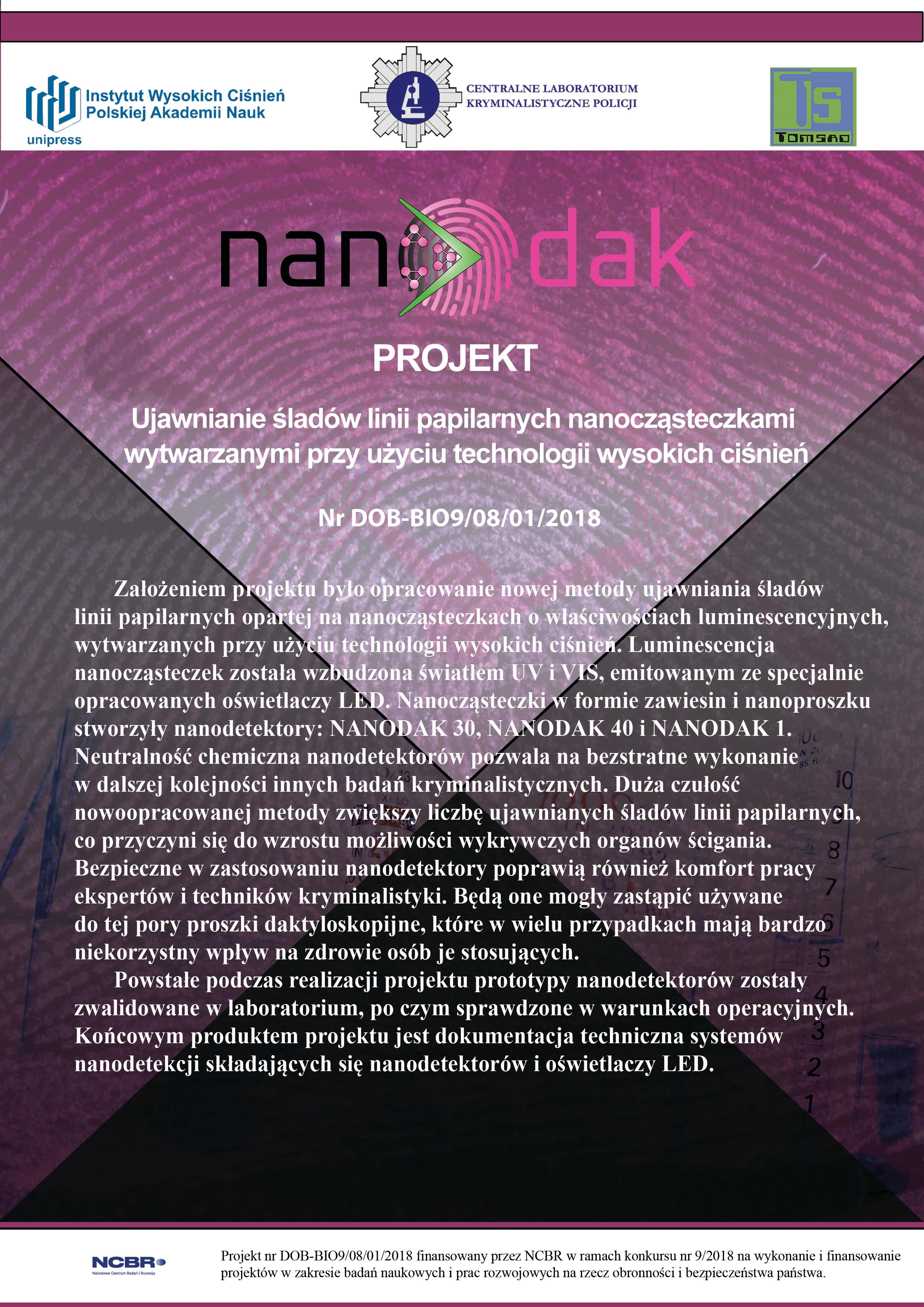Revealing fingerprints with nanoparticles produced using high-pressure technology

 Project title
Project title
Revealing fingerprints with nanoparticles produced using high-pressure technology
 Name of Beneficiary/Beneficiaries
Name of Beneficiary/Beneficiaries
Project leader: Central Forensic Laboratory of the Police
Consortium members:
– Institute of High Pressure of the Polish Academy of Sciences;
– TomSad Tomasz Sadowski company
 Name of programme
Name of programme
Defense and Security Programs
 Competition
Competition
Competition 9
 Project value
Project value
PLN 5,700,961.67
 Funding value
Funding value
PLN 5,700,961.67
 Project delivery period
Project delivery period
03.12.2018 – 31.07.2022
Results of our work
Video
Issues addressed
Fingerprint traces are one of the basic sources of evidence in identifying the perpetrator of a crime. However, before this person can be identified, the perpetrator’s traces must be revealed. As a rule, they are invisible to the unaided eye. In order to visualize them, the Police use a diverse range of methods based on chemical reagents or fingerprint powders. None of the methods used so far is universal and effective enough to reveal all traces left on physical evidence. More sensitive and effective methods of their visualization are still being sought.
As part of the project, new generation preparations for revealing fingerprint traces called “nanodetectors” have been developed. They are based on nanoparticles with luminescent properties enhanced with rare earth element ions. The luminescence of the nanodetectors is excited using 360 nm ultraviolet (UV) light and 410 nm and blue (VIS) light. The source of the excitation light are LED lights dedicated to nanodetectors, specially designed as part of the project. The luminescent properties of nanodetectors make it possible to eliminate the adverse impact of the substrate on the image of the traces.
The set of lights also includes a white light, which allows the observation of traces in conditions close to natural. The NANODAK 30/ND1 suspension nanodetector reveals very well traces on surfaces defined in dactyloscopy as standard ones, featuring high smoothness, for example glass or metal. The NANODAK 40/ND2 nanodetector is more effective on difficult and highly rough surfaces, for example furniture boards. The NANODAK 1/NP nanodetector is a powder suitable for revealing traces left on surfaces by blood or fatty substances. These nanodetectors are safe to use, as demonstrated by environmental tests. The carrier of nanoparticles in suspensions is chemically neutral water. The concentrations of solid particles released during application did not exceed the assumed reference levels – in fact, they were much lower than the values required for the fingerprint powder (argentorate) currently used in practice.
The nanodetectors do not have an adverse impact on other trace visualization methods, which is important if it is necessary to use complementary methods. The analysis of genetic material obtained from individual fingerprint traces revealed by nanodetectors allowed for the definition of the tested subject’s DNA profile. This supports the conclusion that nanoparticles do not interfere with genetic research.
The nanodetectors are easy to apply with a sprayer or brush. They can be used on various types of surfaces, regardless of their characteristics, or on traces made not only by sweat and fat substances, but also by other trace-forming substances (e.g. blood, oils, grease). The nanodetectors are highly sensitive to traces that are several days or even several months old. The use of nanodetectors in forensic examinations at the scene and in the laboratory provides an opportunity to increase the detection capabilities of law enforcement agencies. This is particularly important given the constantly increasing number of crimes related to terrorism and illegal migration.
Project beneficiaries
These new, commercially available, means will expand the range of services offered to clients. The early adapter of the nanodetectors will be forensic technology units and national forensic laboratories carrying out research for the judiciary and the Police. Undoubtedly, services such as the Military Police, Border Guard, and Home Security Agency will be interested in the project results. Then, laboratories in the EU and the USA may become interested, which will create an opportunity for geographical expansion of sales.
